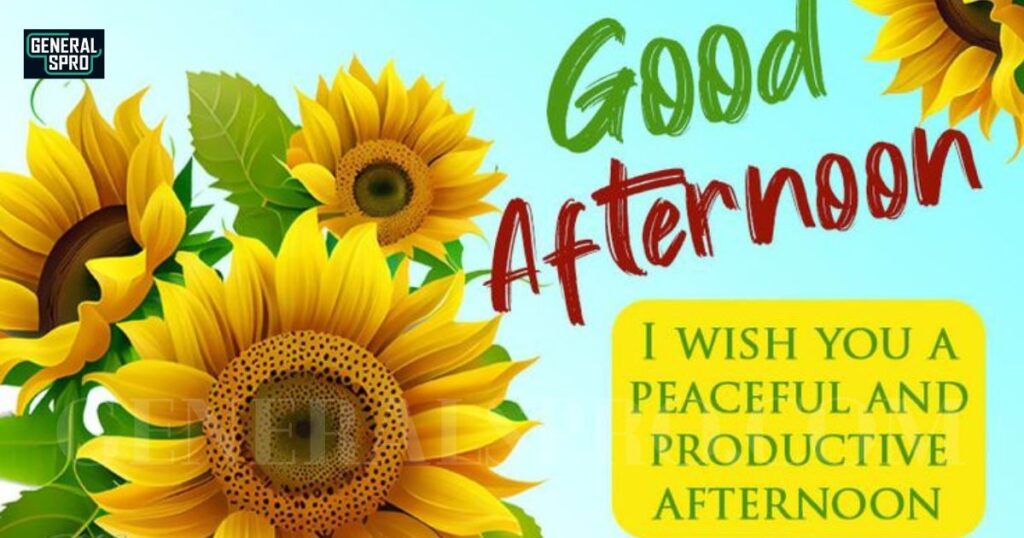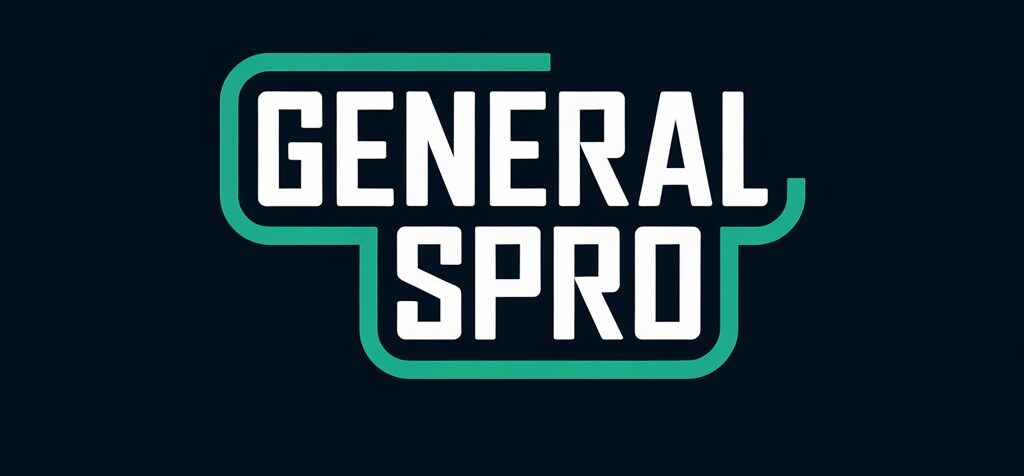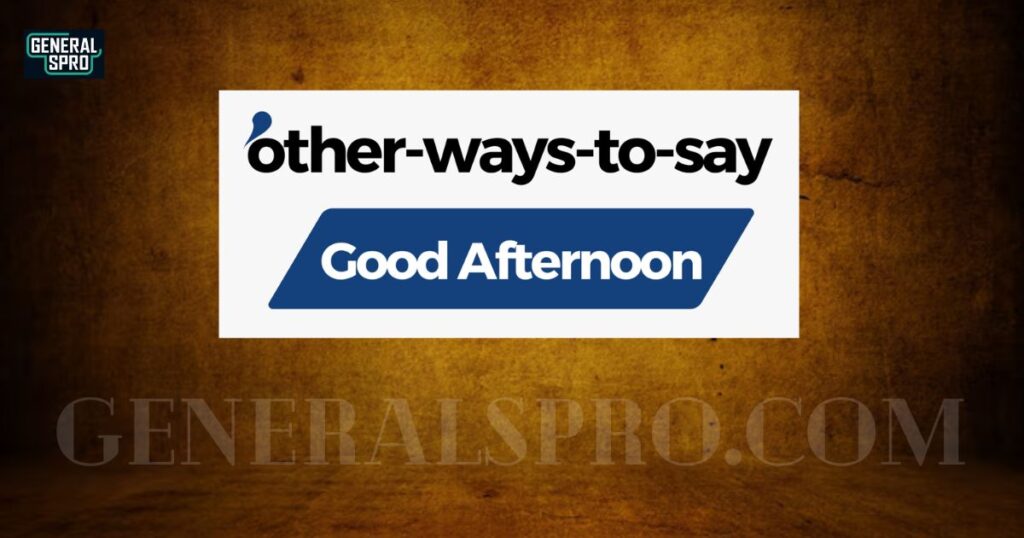How we greet others in today’s fast-paced world can significantly impact our personal and professional relationships.
While “Good afternoon” is a standard greeting, having a diverse repertoire of afternoon salutations can help you stand out and create more meaningful connections.
This comprehensive guide explores creative, formal, and casual ways to extend your afternoon greetings.
How to Say Good Afternoon in Various Settings

The context of your interaction plays a crucial role in selecting an appropriate afternoon greeting.
A formal business meeting requires a different language than a casual encounter with friends. Understanding these nuances helps you navigate social situations more effectively.
In professional settings, maintain clarity and courtesy with greetings such as “I trust your afternoon is going well” or “Greetings this afternoon.” These alternatives convey respect while preserving professionalism.
For casual encounters, you might opt for more relaxed expressions like “Hey there, enjoying the afternoon?” or “Beautiful afternoon, isn’t it?”
Suitable Afternoon, Synonyms and Alternative Phrases
The English language offers numerous elegant variations for afternoon greetings. Consider these refined alternatives that can enhance your communication:
“I hope this afternoon finds you well” is a professional yet warm greeting. “Wonderful afternoon to you” adds positivity to the standard phrase “Afternoon greetings.”
A succinct but polite alternative is “May your afternoon be productive.” Perfect for business contexts.
Some more casual or informal ways to say good afternoon
Your greetings can be more relaxed and creative when interacting with friends or in casual settings. “Hey, how’s your afternoon shaping up?” or “Afternoon, sunshine!” can add personality to your interactions while maintaining warmth and friendliness.
Traditional/Old-Fashioned Ways to Say Good Afternoon
Historical greetings carry a certain charm and can add sophistication to your communication:
“Good day to you” – A classic formal greeting “Pleasant afternoon to you” – Carries an air of refinement “I bid you good afternoon” – Adds a touch of old-world courtesy.
Section 1: Traditional Good Afternoon Messages, Greetings, and Salutations
The beauty of afternoon greetings lies in their versatility. From “Hope your afternoon is going splendidly” to “Wishing you a pleasant afternoon,” these expressions serve as building blocks for more elaborate greetings.
Section 2: Formal and Professional Settings
In corporate environments, maintaining professionalism while showing personality can set you apart.
“I hope this afternoon’s correspondence finds you well” or “Good afternoon, I trust you’re having a productive day” strike an ideal balance between formality and friendliness.
Section 5: Cultural Variations
Different cultures approach afternoon greetings uniquely. “Buenas tardes” is standard in Spanish-speaking countries, while French speakers use “Bon après-midi.” Understanding these cultural nuances demonstrates respect and global awareness.
Section 6: Different Weather and Seasons

Sunny Day
“What a brilliant afternoon we’re having.” “Enjoying this sunny afternoon?” “Beautiful afternoon for [relevant activity]”
Understanding Cultural Impacts on Afternoon Greetings
In different societies, afternoon greetings carry unique cultural significance. For instance, Mediterranean cultures often incorporate warm gestures alongside verbal greetings, while East Asian cultures may emphasize bowing or formal acknowledgments.
Understanding these cultural nuances helps foster respectful international communications and demonstrates cultural intelligence in our increasingly globalized world.
Digital Afternoon Greetings in Modern Communication
The rise of digital communication has transformed how we express afternoon greetings. Professional platforms like LinkedIn and business emails require different approaches than casual messaging apps.
In virtual meetings, a clear and energetic afternoon greeting sets a positive tone for remote collaboration, while email greetings often benefit from a more formal structure that acknowledges time zones and cultural differences.
Psychology Behind Afternoon Greetings
Research indicates that well-crafted afternoon greetings can significantly impact workplace morale and interpersonal relationships. Studies show that personalized greetings increase engagement and create positive emotional connections.
The afternoon period, often associated with decreased energy levels, can be reinvigorated through meaningful social interactions that begin with thoughtful greetings.
Industry-Specific Afternoon Greetings
Different professional sectors have developed their own afternoon greeting conventions. Healthcare settings often emphasize empathy and reassurance, while legal environments maintain more formal protocols.
The hospitality industry combines warmth with professionalism, and educational settings adapt greetings to age-appropriate contexts.
Seasonal Variations in Afternoon Greetings
Each season presents unique opportunities for contextual afternoon greetings. Summer greetings might acknowledge the weather, while winter afternoons call for warmer, more encouraging messages.
These seasonal adaptations help create relevant, timely connections and demonstrate environmental awareness.
Afternoon Greetings in Customer Service
Customer service professionals require finesse in afternoon greetings, balancing professionalism with approachability.
These greetings often set the tone for service interactions and significantly influence customer satisfaction and resolution outcomes.
Multilingual Afternoon Greetings in Business

Global businesses benefit from employees who can offer afternoon greetings in multiple languages. This linguistic versatility strengthens international relationships and demonstrates respect for diverse business cultures.
Time-Zone Considerations in Global Greetings
With remote work spanning multiple time zones, afternoon greetings require careful consideration.
Understanding and acknowledging different time zones shows thoughtfulness and global awareness in international business communications.
Evolution of Afternoon Greetings
Historical records show afternoon greetings have evolved from formal Victorian expressions to modern, casual variations. This evolution reflects broader societal changes in communication styles and social expectations.
Impact of Technology on Afternoon Greetings
Artificial intelligence and automated systems have introduced new considerations for afternoon greetings.
From chatbots to virtual assistants, the technology requires carefully crafted greetings that balance efficiency with a personal touch.
Afternoon Greetings in Social Media
Professional social media platforms have developed their own greeting conventions. Understanding these platform-specific norms helps maintain a professional image while effectively engaging with diverse audiences.
Non-Verbal Components of Afternoon Greetings
Body language, facial expressions, and timing are crucial in afternoon greetings. Understanding these non-verbal elements enhances the effectiveness of verbal greetings in face-to-face interactions.
Afternoon Greetings in Team Building
Strategic use of afternoon greetings can strengthen team cohesion and workplace culture. Thoughtful greetings between team members foster inclusion and maintain positive group dynamics.
Environmental Context in Afternoon Greetings

The physical environment influences appropriate greeting choices. Open offices, formal meeting rooms, or casual break areas each call for different approaches to afternoon greetings.
Therapeutic Benefits of Positive Afternoon Greetings
Research in positive psychology suggests that genuine, joyous afternoon greetings can improve mental well-being for both the greeter and the recipient.
These interactions create micro-moments of connection that contribute to overall workplace satisfaction and personal relationships.
Frequently Asked Questions (FAQs)
What’s the best time to transition from “good morning” to “good afternoon”?
The traditional transition occurs at 12:00 PM (noon), though many consider the shift acceptable between 11:30 AM and 12:30 PM, depending on your location and cultural context.
Should I use formal or casual afternoon greetings in a hybrid work environment?
In hybrid settings, maintain slightly formal greetings for professional interactions while allowing more casual greetings during informal team conversations. Consider the specific context and audience.
How can I make my afternoon greetings more memorable in business emails?
Personalize your greeting by referencing specific projects or shared experiences while maintaining professionalism. Avoid generic phrases and consider adding relevant context.
Are afternoon greetings necessary in quick digital messages?
Brief acknowledgments remain essential for maintaining professional courtesy, even in quick digital exchanges. A simple “Hi” or “Afternoon” helps establish a positive tone.
How do afternoon greetings differ across global business cultures?
Different cultures have varying levels of formality and specific timing conventions for afternoon greetings. Research cultural norms when dealing with international colleagues or clients.
What role do afternoon greetings play in customer service?
Afternoon greetings set the initial tone for customer interactions and can significantly impact customer satisfaction. They should be warm, professional, and appropriate to the service context.
How can I avoid sounding repetitive with afternoon greetings?
Vary your greetings based on context, recipient, and situation while maintaining consistent professionalism. When selecting appropriate variations, consider the purpose of your communication.
Should emojis be included in professional afternoon greetings?
Reserve emojis for casual or internal team communications where such informal elements are accepted. Maintain emoji-free greetings for formal business correspondence or external communications.
Conclusion
Mastering different ways to say good afternoon enriches your communication toolkit and helps you build stronger relationships across various contexts.
Whether in a professional setting, casual environment, or cross-cultural situation, diverse greeting options allow you to communicate more effectively and authentically.
Remember that the most effective greeting matches the situation while reflecting your personality. Practice these variations to find what works best for you in different contexts, and don’t be afraid to adapt them to suit your specific needs.
By expanding your repertoire of afternoon greetings, you’re not just saying hello – you’re opening doors to better communication and stronger connections with those around you.








